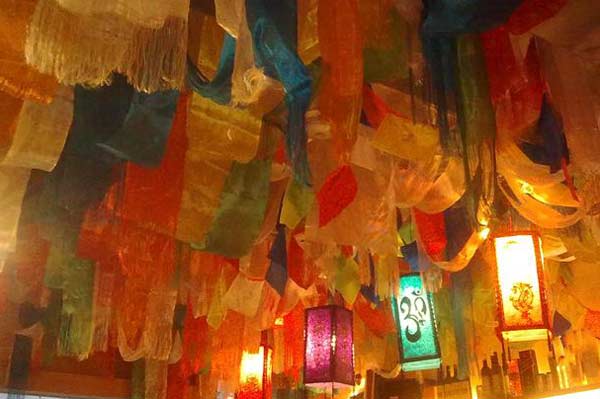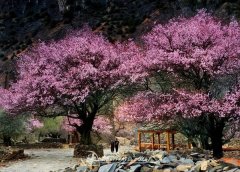
Khada: a cultural icon of Tibetan people

Photo shows colorful khadas hung on the ceilings of a Tibetan restaurant.
Presenting khada is a widespread etiquette unique to the Tibetan people, which is to show respect or pray for Buddha's blessings.
Khada is often presented to guests and seniors as a way to show respect and regards on festive occasions, weddings and funerals, and to deities out of pious respect or for Buddha's blessings on religious rituals or when people are on their pilgrimage. Besides, it can also be offered to items for auspiciousness, such as vehicles upon departure as a wish for peace and safety, or to yaks for flourish and harvest when the spring sowing begins, and so on.
There's no unanimous classification of khada, yet normally it can be categorized into special and common classes, the former of which is usually for special guests, accomplished lamas and rinpoches, while the later for common friends and guests. Different types of khadas have different textures, decorative patterns, and sizes.
The colors of Khada
There are yellow, green, red, white and blue khadas. The white and yellow ones are mostly seen in Tibetan inhabited areas while other colorful khadas can be seen in some Mongolian areas where Tibetan Buddhism is prevalent.
The five colors of yellow, green, red, white and blue correspond to the five components of universe in Tibetan culture, namely earth, water, fire, wind (cloud) and sky.
Khada with five colors is generally consecrated to Buddhas and could also be used on weddings. According to Buddhist doctrine, khada with five colors is the costume of Bodhisattva, and is presented to specified people at special occasions. For example, yellow khada is often presented to living Buddha (rinpoches) or accomplished lamas; whereas, the most commonly seen white khadas are offered to each other by secular people.
Nowadays, more and more factories that manufacture khadas spring up and the cost becomes less and less. The real silk khadas become fewer, which is often the classic type of khada.

With exceptional passion and outstanding leadership, Mrs. Catherine has dedicated herself to Tibet inbound tourism and China tour for 15 years. As one of the handful females who see great potential of Chinese inbound tourism, Catherine has made great contribution to promoting Tibet tourism and enhancing the employment of Tibetans and prosperity of local Tibetan community.
Over the years, she travelled overseas with Tibet Tourism Bureau many times to promote Tibet tourism. Currently, Catherine works as the marketing director of Tibet Vista, an opinion leader behind the whole team of Tibet Vista.
Related Articles & Posts

Latest Tibet Travel News

Tibet Vista: A Social Responsible Tour Organizer
Aug 14,2023

Tibetan Monks Debate in Drepung Monastery
Jun 10,2023

Tips for Traveling to Tibet in Spring
Feb 17,2022

Snow Will Hit Qinghai-Tibet Plateau
Feb 17,2022


.jpg)




0 Comment ON "Khada: a cultural icon of Tibetan people"